Drake London Was the Best Pick in Drafts
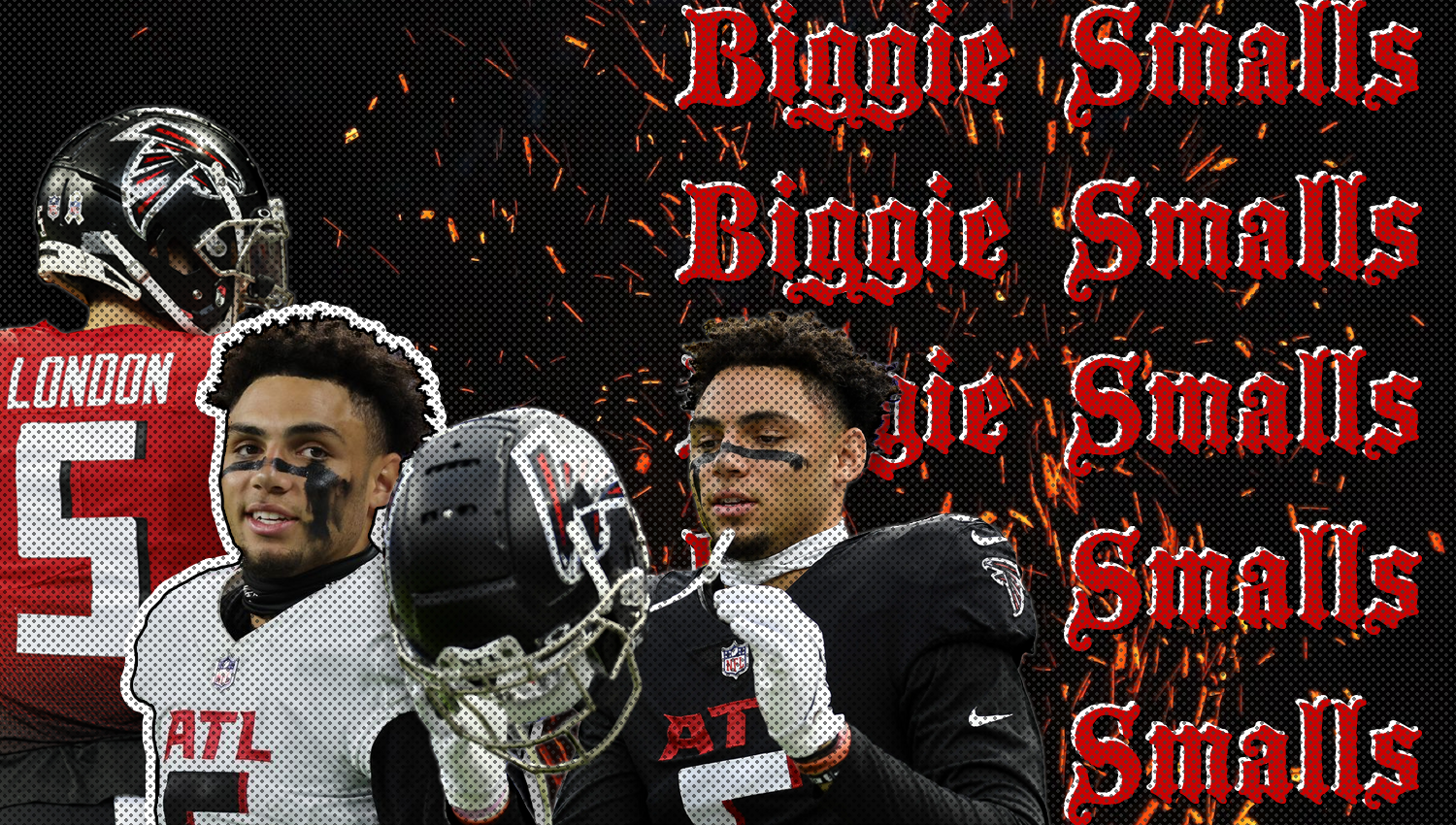
Welcome back to fantasy football and the 2023 NFL Season! Hope you drafted Drake London. You couldn't afford not to!
His average draft position across all major fantasy platforms as of September 1, 2023, was:
- WR22, 47th overall on Yahoo!
- WR23, ADP of 45.3 on Underdog
- WR24, 56th overall on Sleeper
- WR25, 52nd overall on DraftKings
- WR26, 68th overall on ESPN
FantasyPros Expert Consensus Rankings, which pulled the rankings of 155+ experts across the fantasy football industry, had London ranked as:
- WR23, 50th overall in half-PPR scoring
- WR23, 43rd overall in PPR scoring
Looking back at these rankings in the spring of 2024, isn't it crazy we were able to select a Top 5 WR at the 4-5 turn in fantasy drafts last season?
We were so afraid of the Swag Dracula, Arthur Smith!
Arthur Smith looks like a vampire who feeds only on Kyle Pitts owners. pic.twitter.com/Bvs2iJ9G9T
— Jordan Loupe (@CantALoupe_FF) October 3, 2022
Even Vegas was terrified.
Drake London's odds to finish as Offensive Player of the Year were +20,000 despite Arthur Smith being tied for second in Coach of the Year odds at +1,400.
London's OPOY odds were third on his own team, behind Kyle Pitts (+15,000) and Bijan Robinson (+4,000).
Sportsbooks set London's season-long props at:
- 825 receiving yards
- 69.5 receptions
- 4.5 touchdowns
The thinking behind those numbers was relatively simple.
In the four games Desmond Ridder started in 2022, he threw the ball roughly 30 times a game and hyper-targeted London, so it was fair to expect London's target share to settle in around 25%.
Based on London's route participation in 2022, the books seemed to set his line at 25 routes per game. If he saw a target on roughly 25% of those routes, that translates to about 6 targets in each contest.
Then, they took that number and multiplied it by 63.2%—the percentage of targets London was able to catch in 2022—to project about 4 receptions per game in 2023, and seemingly applied London's 12 yards per reception in 2022 to project 48 yards per game in 2023, bringing his season-long projections to:
- 816 receiving yards
- 68 receptions
Oh, and the books were projecting Ridder for roughly 14.5 to 15.5 touchdowns.
So, if you multiply those projected Ridder TDs by London's 25% target share you land on about 4 TDs for London, or slightly under Vegas's 2023 season-long prop.
816 receiving yards, 68 receptions, and 4 touchdowns projected in the 2023 season for the former Top 10 NFL Draft pick who was the first wideout taken in one of the best WR classes of the modern era.
Hmm, so Drake London was going to perform to the standard of that four-game sample with Ridder for the duration of the 2023 season, without any hope for improvement?
Despite an enormous amount of evidence that a breakout was about to happen?
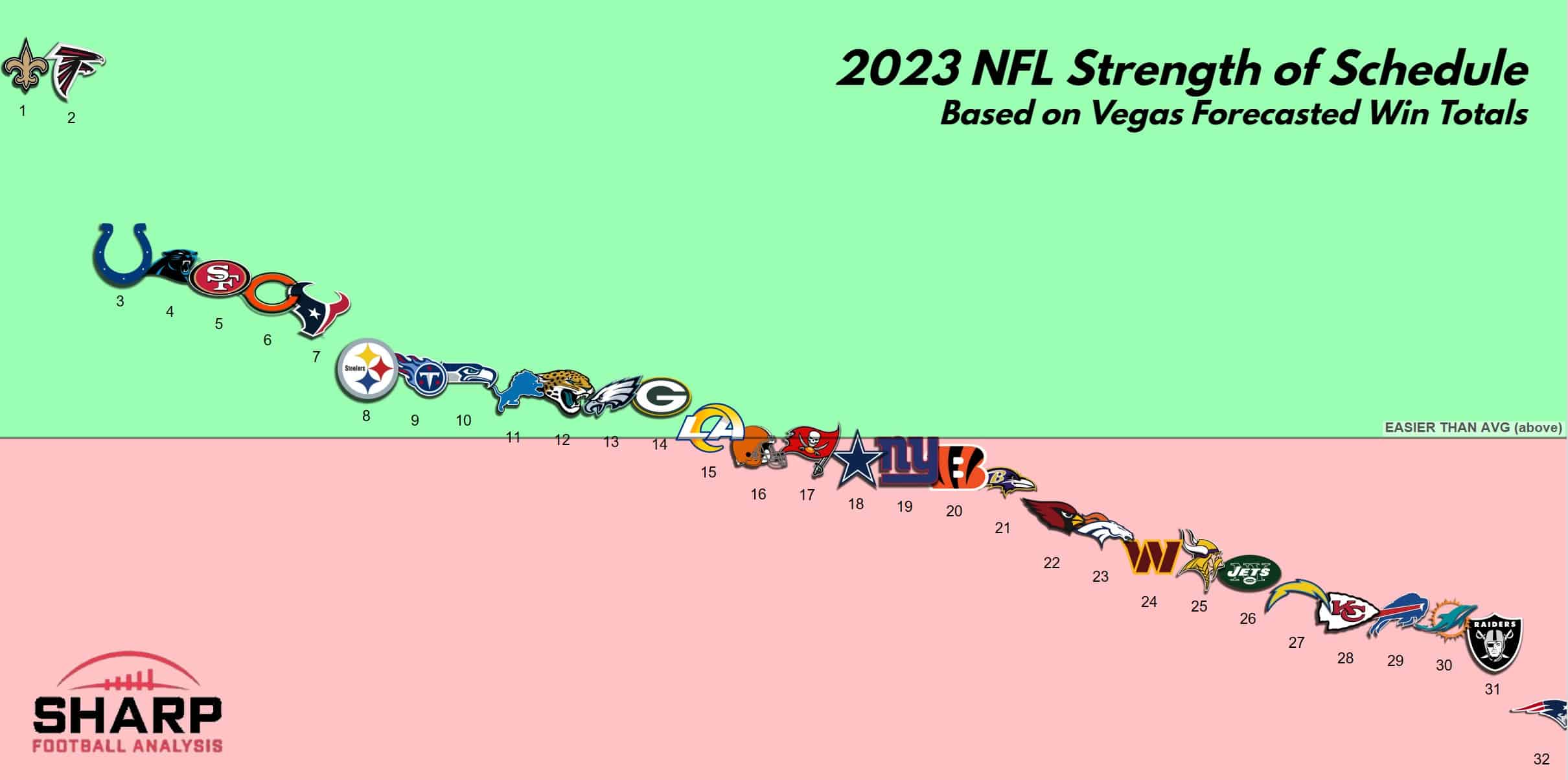
The Falcons benefited from a very easy strength of schedule in 2023, no doubt.
Free Safety Jessie Bates III led a strong enough, revamped Atlanta defense that was able to limit opponents' drives and overall time of possession.
In turn, the Falcons offense benefited from a boost in total plays, which led to higher attempts across the board for Atlanta's top skill players.
Bijan Robinson and Tyler Allgeier led the league's most efficient rushing attack, which opened up the play-action game and allowed Falcons receivers the time they needed to find soft spots in the defense over the intermediate part of the field.
Why the intermediate part of the field? Allow me to explain.
To read the rest of this post, subscribe for free!
It has to do with the popularity of Vic Fangio's defensive system taking over the NFL as the base defensive alignment (4-2-5) showing two high safeties.
Essentially, the way the Fangio defense works is it shows offenses the exact same alignment before the ball is snapped on every play.
After the ball is snapped, the defense shifts into their desired coverage and the quarterback has to quickly diagnose how the defense is playing before making the correct read to advance the ball downfield.
The "two high shell" that the Fangio defense is known for means they are showing two high safeties before the snap, and they're meant to cover roughly half the field to limit explosive plays that go for 20+ yards.
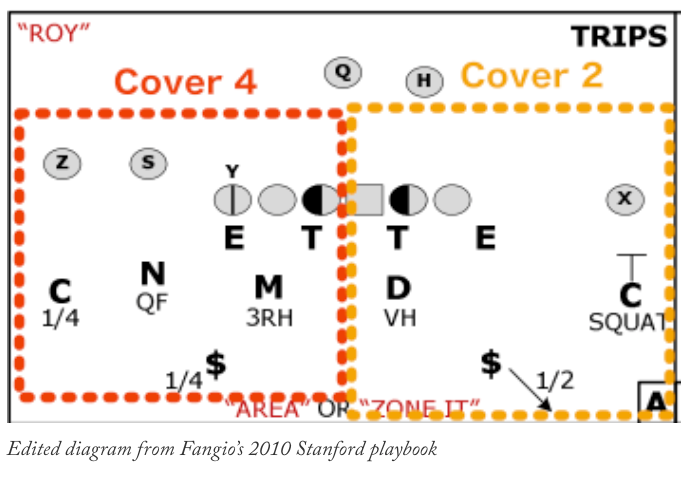
One of the main differences in the Fangio defense versus traditional 3-4 or 4-3 alignments is one of the linebackers has been replaced with a nickel cornerback to match up against the offense's slot wide receiver.
Given the explosion in 11 personnel usage—plays in which the offense's formation has 3 WR, 1 TE, 1 RB—the Fangio defense allows teams to better match-up against high-powered offenses by using this 4-2-5 alignment.
Now, I could really go down a rabbit hole about why these changes have impacted the salaries of running backs and linebackers, etc., but I'm going to try and stay on task and relay that, per analysis in The Washington Post and The Athletic, anywhere from a quarter to a third of the league was running some variation of the 4-2-5 Fangio defense as their base set in 2022.
In 2023, it was projected that all but one team (the Vikings) would show 4-2-5 more often than not as their base defensive set.
With 31 out of 32 teams projected to roll out the same base defense that limits explosive plays of 20+ yards and forces quarterbacks to quickly process the defensive shifts after the snap, most teams have invested in smaller receivers who are able to quickly separate from defenders near the line of scrimmage and attack the short and intermediate parts of the field to get yards after the catch.
The Atlanta Falcons under Arthur Smith have not operated like most teams.
After kicking the tires on 6'3" Bryan Edwards last season, the Falcons went out and prioritized signing 6'4" Mack Hollins during the first week of free agency. Kyle Pitts stands 6'6" and Drake London is 6'4". The Falcons have prioritized bigs as others have gone small.
The Jets' Garrett Wilson (6'0"), Saints' Chris Olave (6'0"), and Commies' Jahan Dotson (5'11") fit the modern prototype teams have been trying to deploy as the engine of their offense in 11 personnel sets.
Right around six feet tall and 185-200 pounds seems to be the ticket. Top fantasy WRs like Justin Jefferson, Ja'Marr Chase, and Stefon Diggs all fit within these dimensions, plus or minus an inch or a couple pounds.
Drake London, as I mentioned, does not.
This has led to a bit of a tall vs. small bias in the fantasy community, with managers worrying about Drake London being more of a boom-bust, injury-prone option like a Mike Williams or a touchdown- and explosive-play dependent Mike Evans in an NFL that is actively trying to limit plays of 20+ yards downfield.
But Drake London doesn't move like your typical big-bodied receiver.
He has consistently demonstrated the ability to separate and get open like the smalls currently dominating the fantasy landscape.
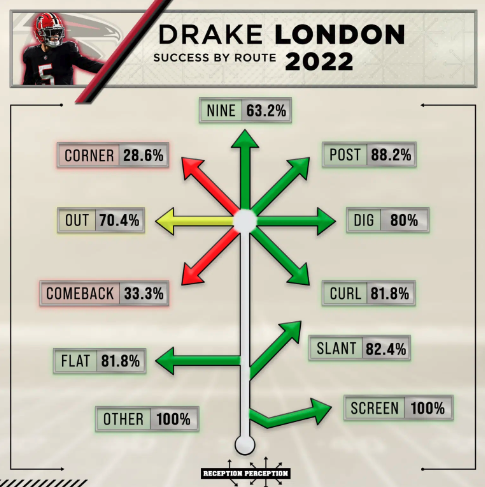
Reception Perception's Matt Harmon had this to say about London in his 2022 player profile:
The Falcons absolutely love using London in the short to intermediate area.
His strength is being able to gain immense separation on short and intermediate routes, especially slants, curls, and digs. His ability to win against man and zone coverage on these base NFL routes is why I think he’s destined to become a high volume No. 1 receiver.
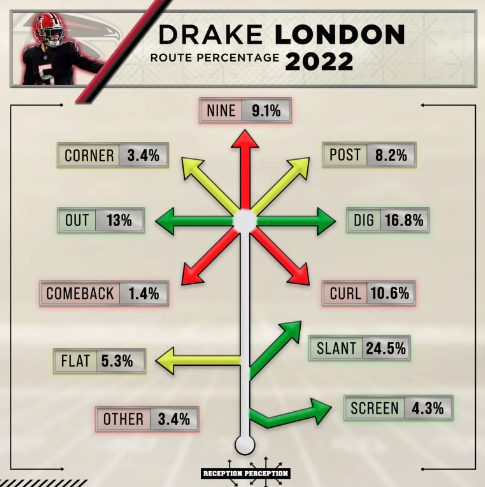
Harmon added:
As a long-strider, he sneaks up on you once you get the ball in his hands working over the middle. He’s not blazing fast nor a big-play machine as a tackle-breaker – he broke multiple tackles on just 4.5% of his “in space” attempts – but he’s extremely [deceptive] and can run away from guys thanks to those strides.
So he doesn't have the top speed of the smalls but he makes up for it with his gazelle-like strides, and to be honest that's just the cherry on top.
The key to his impending fantasy breakout is he's getting open in the intermediate part of the field where the Falcons love to pass the ball.
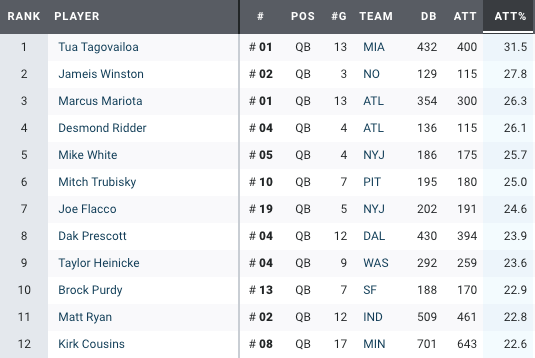
Marcus Mariota and Desmond Ridder ranked 3rd and 4th in the NFL last season in the percentage of their passing attempts to the intermediate part of the field (10-19 yards past the line of scrimmage), both eclipsing 26% in 2022.
New Falcons backup QB Taylor Heinicke ranked 9th, targeting the intermediate part of the field 23.6% of the time last season.
Not only were Mariota and Ridder in the top 5 of intermediate passing attempts, they were also very good at it, per Pro Football Focus.
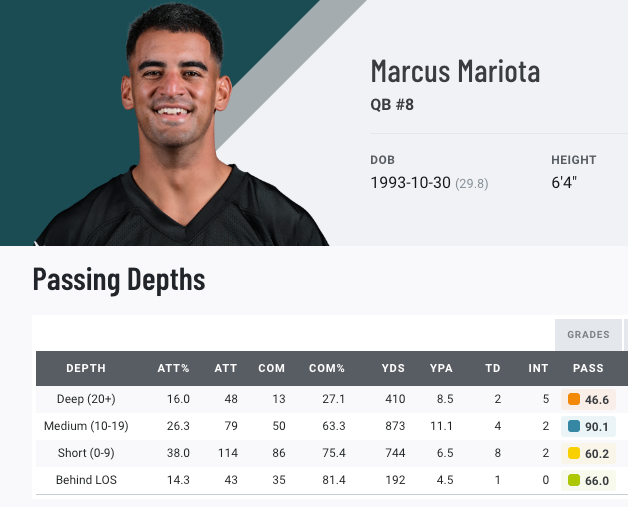
For all the grief Marcus Mariota received as a passer last season, the dude was elite at delivering the ball to the intermediate part of the field, scoring a 90.1 passing grade according to PFF.
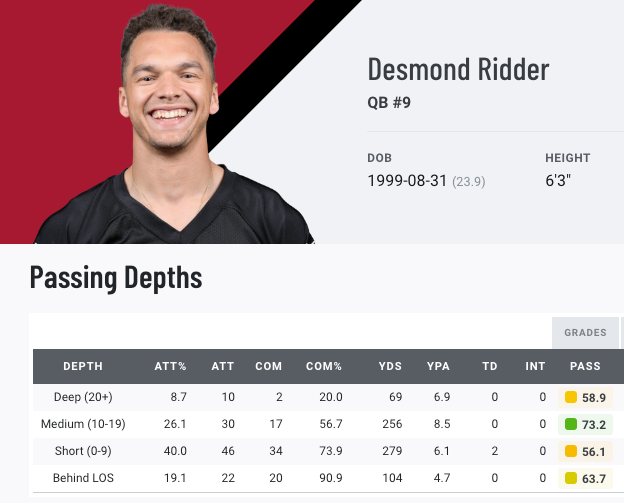
Ridder wasn't elite but above average—compared to other passers—earning a 73.2 grade from PFF on all throws over the intermediate part of the field.
When specifically looking at throws to the parts of the field where Drake London was most successful, though, Ridder was better than good.
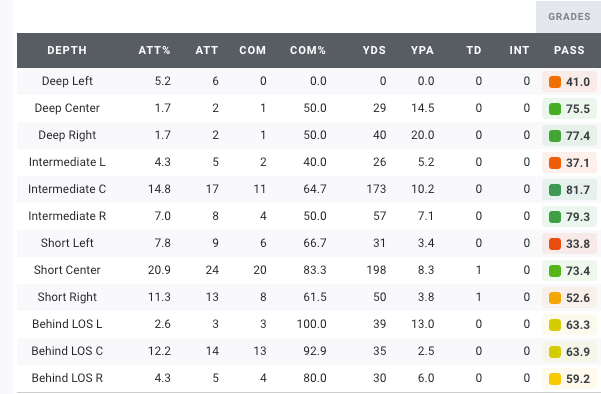
In the intermediate center and right, he earned marks of 81.7 and 79.3, respectively. These are the areas of the field where London ends up on his slant, curl and dig routes, which he ran more than half the time.
Ridder was even solid—better than solid—over the deep center and deep right parts of the field, earning a 75.5 and 77.4 grade from PFF. These areas of the field align with post routes, which London should be running when the Falcons look to take advantage deep off of play-action.
That's when being 6'4" and nearly 220 pounds really pays dividends against smaller defensive backs. But again, London can do most of his damage in the part of the field that isn't specifically being taken away by the defense.
In fact, it seems the Fangio defense would prefer quarterbacks to throw to the intermediate part of the field.
Going back to the 2022 passing stats and looking at the top 12 quarterbacks who had the highest percentage of intermediate throws, what jumps out?
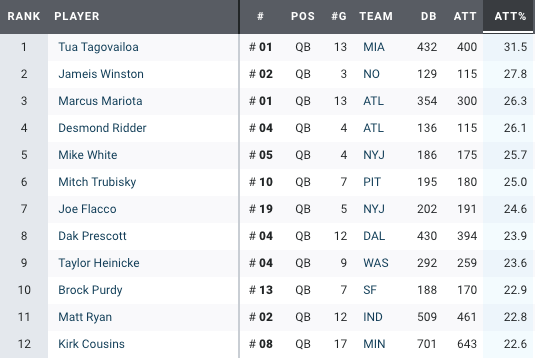
Tua Tagovailoa, Mike White, Joe Flacco, Brock Purdy, and Kirk Cousins all played in offenses rooted in the Shanahan-McVay coaching tree, which looks to get players open in space.
Mike White now backs up Tua in Miami for Mike McDaniel's Dolphins and they're literally going up against Vic Fangio's defense in practice every day, as the godfather was brought in as defensive coordinator this offseason.
What jumps out to me, though, in this list specifically, is that these quarterback's playcallers—Mike McDaniel, Kevin O'Connell, and Kyle Shanahan—are all intimately familiar with the Fangio defense and the ways to attack it.
They said as much on The Athletic's Playcallers podcast series.
Basically, Sean McVay's Rams lit up the entire league in 2018 with explosive plays until Vic Fangio's Bears took away the Rams ability to hit explosives, and that was further compounded by the Rams loss to the Patriots in Super Bowl LIII when Bill Belichick ripped off Fangio's defense to stymy the previously explosive McVay Rams, holding them to just three points.
Since then, the Fangio defense has grown in popularity alongside the McVay-Shanahan offenses and both have taken over the league.
The offenses have focused on attacking the Fangio defenses underneath—either at, behind, or just beyond the line of scrimmage—"manufacturing touches" for their best playmakers by getting them open in space.
The playcallers do this in creative ways, by sending a receiver in motion before the snap to try and get a read on the defense, or by stacking WRs one behind the other at the line of scrimmage so their smaller, speedier receivers are shielded from press coverage and can get to the open space faster.
The way The Playcallers podcast wraps up is a series of questions about where the offense goes next—what will be its next evolution. The playcallers, of course, didn't take the bait and passed on telling the world what they plan on running in 2023.
Robert Griffin III and Andrew Whitworth, who played in the system in Washington and Los Angeles, respectively, expect the offense to be more run-focused in its next evolution.
However, I really think the evolution has already begun and it involves attacking the intermediate part of the field, hoping to turn those 10-19 yard gains into 20+ explosives as the defenses start to take away the shallower stuff that has worked so successfully in post-pandemic seasons.
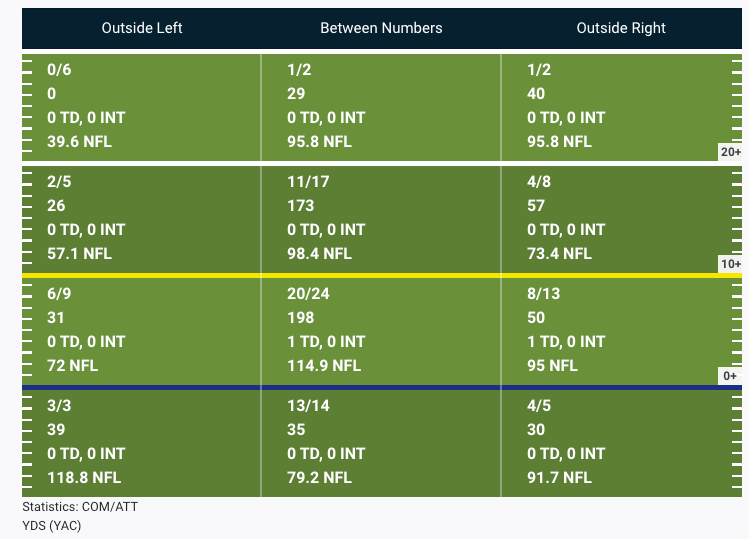
If defenses still allow the shorter stuff, if they prefer to try and increase the amount of plays an offense has to run, dinking and dumping the ball down the field, trying to frustrate them and get them to make mistakes, then Desmond Ridder should be more than capable of attacking defenses short.
If, however, defenses start to key-in on the short game and take that part of the field away—in addition to limiting explosive plays 20+ yards downfield—and they start daring offenses to target the intermediate middle of the field, which is a tougher throw to make for most quarterbacks, then watch out.
Drake London will feast.
In four games with Desmond Ridder last season, London totaled 25 receptions and 333 yards.
As you can see from the charts below, courtesy of Next Gen Stats, London did most of his damage over the intermediate middle of the field.
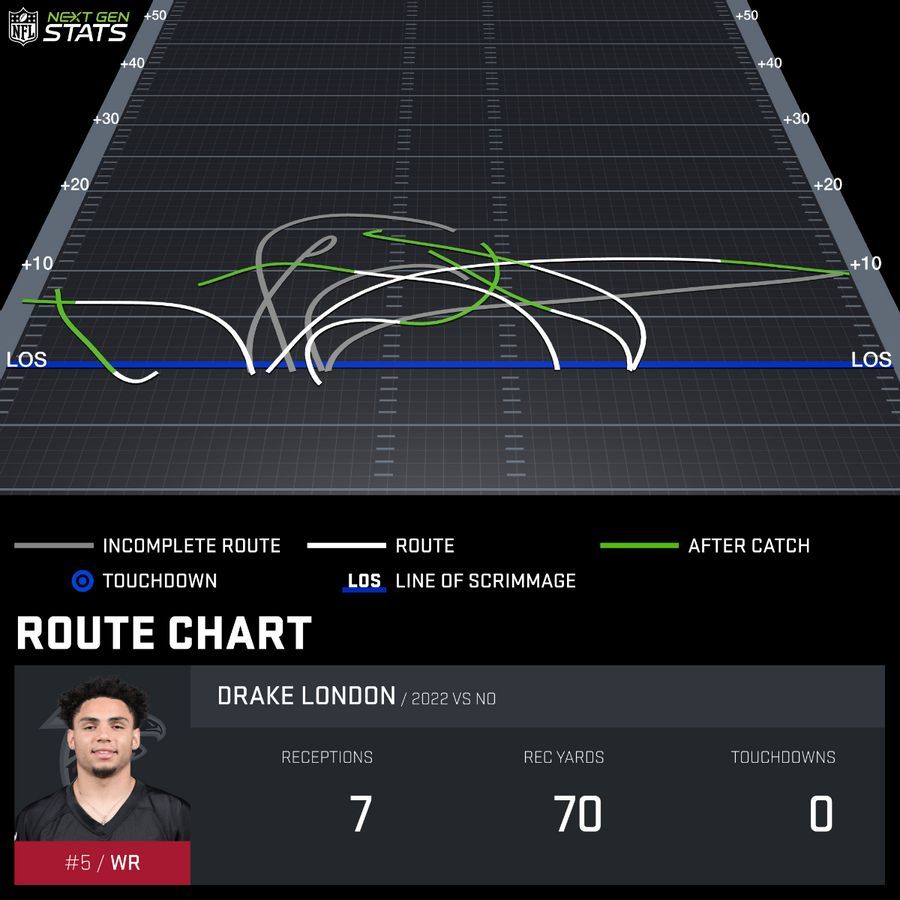
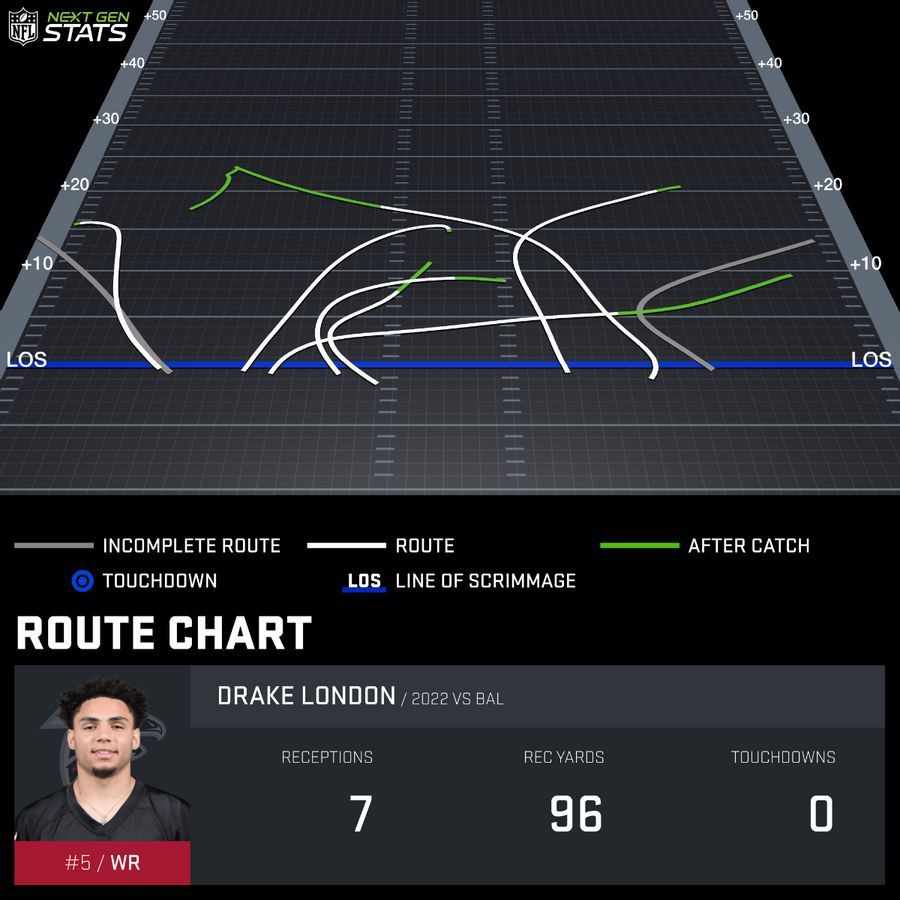
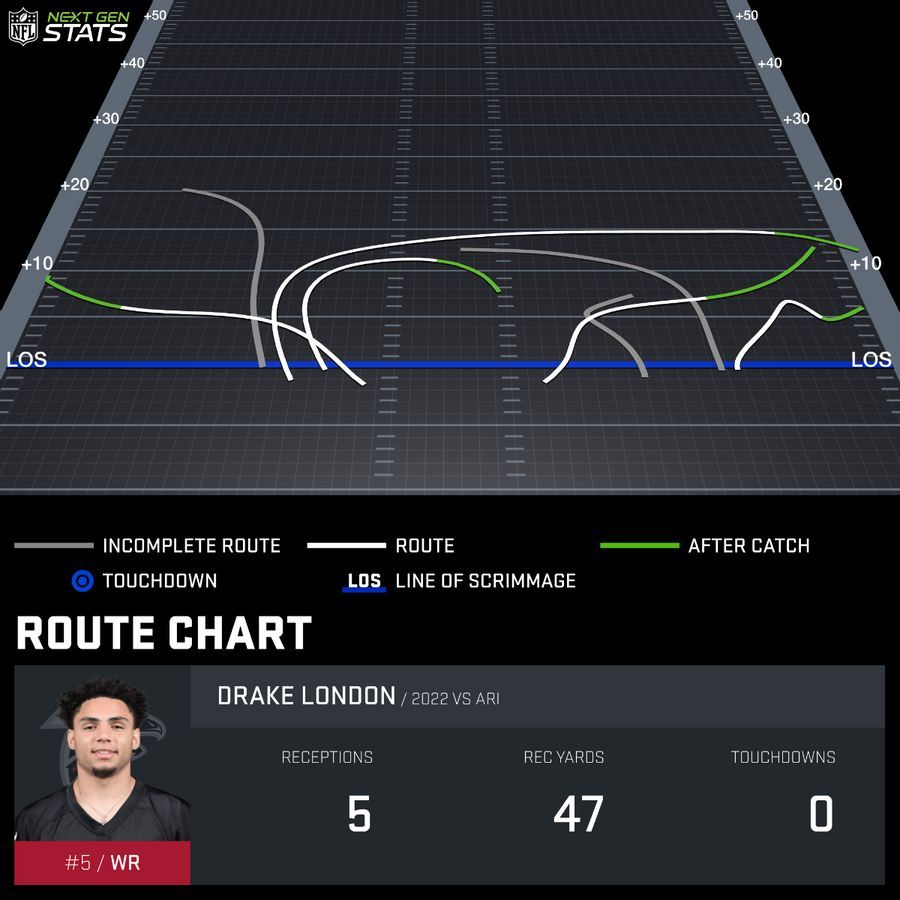
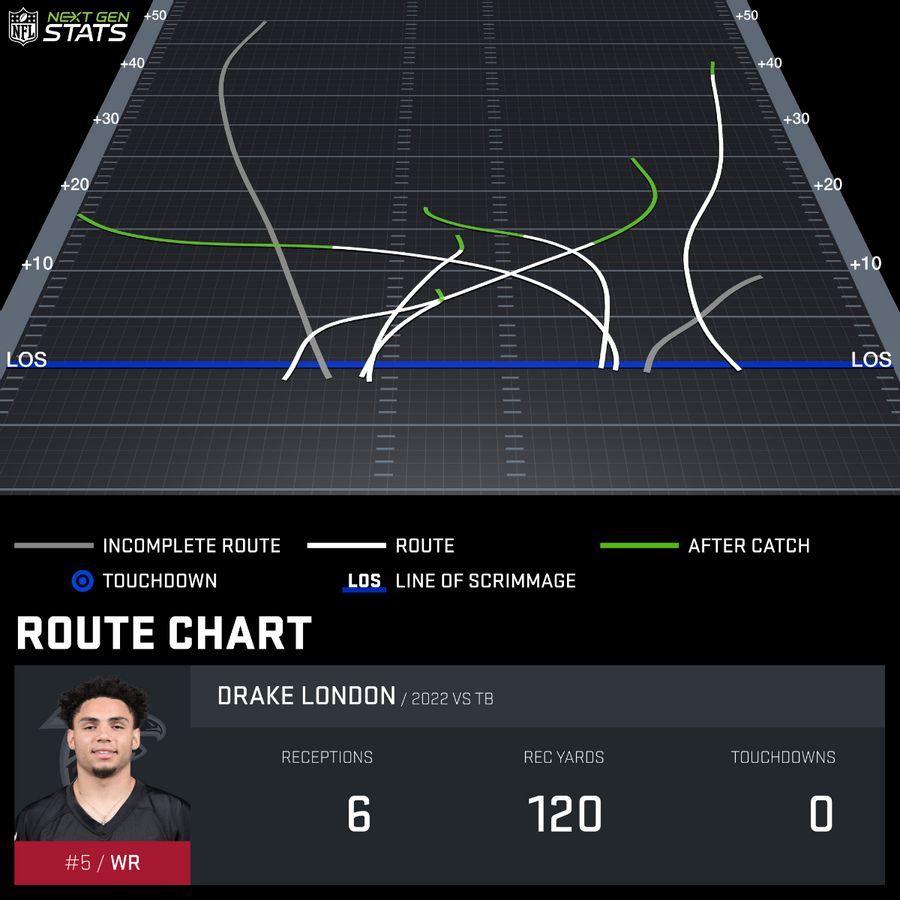
So, alright. OK.
Let's pump the brakes a little and go back to London's 2023 Vegas player props:
- 825 receiving yards
- 69.5 receptions
- 4.5 touchdowns
In half-ppr scoring, that comes out to 144.3 fantasy points, which would've been good for a WR29 finish in 2022, just behind Curtis Samuel.
In PPR scoring, that comes out to 179 fantasy points, which would've landed in the bunched up WR26 or WR27 range in 2022, right in the mix with Jerry Jeudy and JuJu Smith-Schuster.
For the record, Chris Olave scored 183.2 points in 2022; Garrett Wilson scored 197.8 points.
OK, back to revving up the engine.
I get it, alright: It's not realistic to assume Drake London's going to have 6+ receptions every game and go for 83 yards per, but I do think it's fair to dial up his projection a little north of Vegas's cautious expectations of 4 receptions for 50 receiving yards per game.
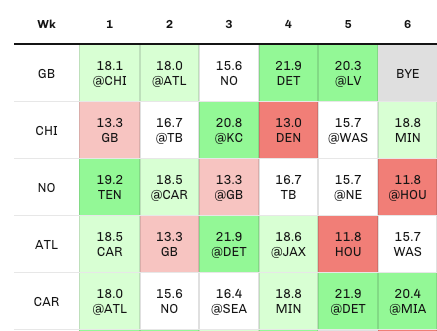
The Falcons begin the season with five games indoors and a trip to England to face the Jaguars. Overall, they play 11 games indoors during the fantasy football season (Weeks 1-17), and hopefully have two nicer weather games at Tampa Bay and Tennessee in Weeks 7 and 8.
What, you don't think the weather or playing conditions matter!?
Anyway, let's say Drake London runs 30 routes a game instead of 25, but we'll keep his target share at 25% from Ridder.
That puts London at 7.5 targets per game.
In the four games with Ridder last season, the percentage of targets London actually caught was 71.95%—better than his season long average of 63.2%.
So let's say he can get to 66.7%, catching two-thirds of every pass that comes his way. That puts him at 5 receptions per game.
Now here's the tricky part, because those 83 yards per game with Ridder are much higher than the Vegas line would indicate, but doesn't it seem like London should be able to get to 1,000 yards this season?
60 yards a game? 1,020 yards on the season? He gets loose on a couple play-action deep posts thanks to the defense having to account for Bijan and Pitts? For Mack fucken Hollins?
Come on! It's not that big of a stretch!
OK, so let's say he ends up with 75 receptions for 980 yards and 5 touchdowns. Less than what I just went through but more than the Vegas season props.
- In half-ppr scoring, that would be good for 165.5 points, which would've been the WR20 last season, just behind DJ Moore.
Mike Evans finished as the WR11 in 2022 with 186.9 half-ppr points, just 21.4 more points over the course of the 17-week fantasy season or 1.3 fantasy points per game. - In PPR scoring, that would be good for 203 points, which would've been the WR21 in 2022, just behind Michael Pittman.
Mike Evans also finished as the WR11 in PPR scoring with 225.4 points, or just 1.3 fantasy points per game more than this reasonable 2023 Drake London projection!
Come on! What were we doing during the 2023 draft season. Why were we so afraid to draft Biggie Smalls!
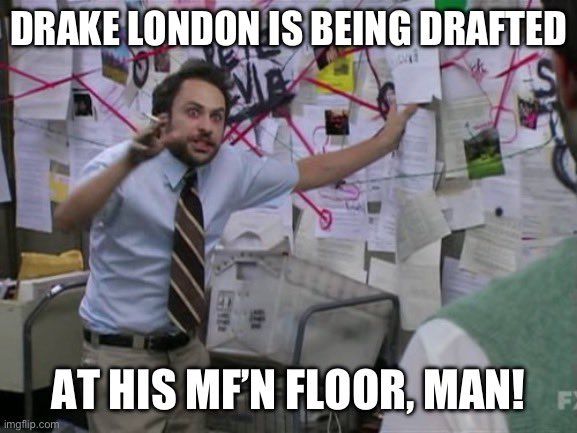
The fact is Drake London saw 35 targets in the four games with Ridder last season, or nearly 9 targets per game.
When you adjust those for Ridder's attempts, though, it gets a little ridiculous:
- Week 15: 11 targets on 26 attempts = 42.31% target share
- Week 16: 9 targets on 33 attempts = 27.27% target share
- Week 17: 7 targets on 26 attempts = 26.92% target share
- Week 18: 8 targets on 30 attempts = 26.66% target share
In every game, London finished with a higher target share than what has been projected for him thus far.
Isn't this what we're looking for in fantasy, a condensed offense with a few stars who get all the opportunity?
What if Drake London finishes the season with a 30% target share? Is 100 catches in his range of outcomes? How about 1,250 yards? 10 touchdowns?
Come on! Why were we so scared during 2023 drafts!
*Deep breath*
You've made it this far, and you clearly know the value of reading, so I'll leave you with this.
Back in April, The Athletic's Jeff Schultz started the 2023 Falcons drumbeat.
He published a piece filled with intel about how the Falcons were approaching the upcoming season, and how they had been building for this moment.
“I feel like a coach who’s been on probation with only 50 scholarships out of 85 — and now it’s, ‘All right, things are even,’” Arthur Smith told The Athletic.
When Smith and GM Terry Fontenot took the job, they explained to Falcons owner Arthur Blank that it would be a process before they got to where they needed to be.
“We explained it would take two years, possibly three, depending on Option A or Option B. We said we understand the best thing to do is to eat this because we’re going through a transition anyway. These guys, whether we want them to play forever or not, they’re not. They’re on the back nine of their career. There was a clear understanding where we wanted to go. We were going to make a lot of transactions, we were going to try to find a lot of guys who would take these one-year deals, get this draft class as best we can, and then go from there.”
2023 is Year 3 for the Arthur Smith Falcons.
The Falcons spent $100 million in free agency and added their third Top 10 skill player in the Draft. They should have a much-improved defense and a better offensive line that allows Ridder to find Pitts, Bijan, and London.
"This was Smith's plan all along — to strengthen around a young quarterback before throwing him in there."
Often, the best way to win in fantasy football is by being a year early on the players people were overlooking, for whatever reason. In Drake London's case, people are afraid of Arthur Smith and how he'll deploy London and Pitts. They seem to be fine taking Bijan Robinson at the 1/2 turn, but London and Pitts have been values in drafts all offseason.
The path to a Top 12 wide receiver finish in 2023 for Drake London is clear, and yet people are saying he's closer to the WR2/WR3 borderline in drafts.
Come on!
Looking back at this in the spring of 2024, isn't it crazy we were able to select a Top 5 WR at the 4-5 turn in fantasy drafts?
